Canning onions is a great way to keep them for longer and use them in your recipes year round.
They’re nice to have on hand, and perfect to use in stews, soups, sauces, or any other recipe.
The canning process makes the onions slightly caramelized, which adds extra flavor and richness.
What I love most is how easy this process is. Follow along below as I walk you through step by step on how to can your very own onions at home.
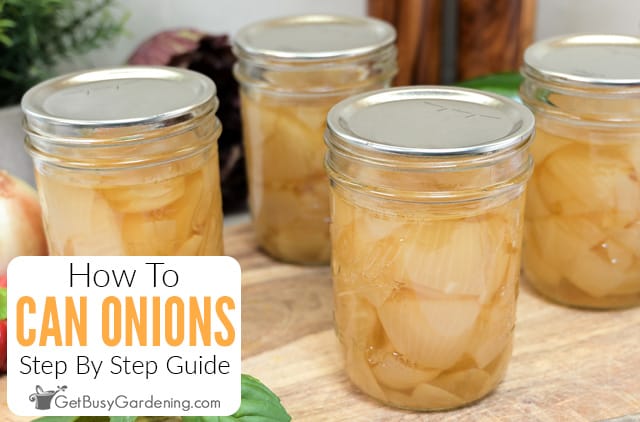
Can Onions Be Canned?
Yes, onions can be canned with minimal ingredients and tools you probably already have on hand.
It’s a great way to preserve them from your garden, and save yourself some time making recipes later on. Use them in any dish that calls for cooked onions.
Best Types Of Onions For Canning
When choosing what onions to can, there’s really no best type. Use any variety you have, red, white, yellow, and even pearl onions.
The most important factor is that they are firm and fresh with no soft spots or sprouts forming.
Related Post: How To Grow Onions At Home
Preparing Onions For Canning
Preparing onions for canning is easy, but does take a bit of time. First, cut both of the ends off, remove the outer skin, and rinse off any dirt.
Then cut them into 2 inch wedges or chunks before filling your jars. You can leave small onions whole, or cut them in half.
Methods For Canning Onions
There are two methods you could use for canning onions: hot or raw packing. Although there’s not a wrong method for this, I have found my preference and will share below.
Hot Packing
With the hot packing method you flash-cook the onions in boiling water for 1 minute before filling your jars.
The benefits of hot packing include the reduction of extra air bubbles, and better color and flavor preservation.
The drawback is that it cooks the onions, which tends to cause them to become mushy after canning. So I recommend raw packing them instead.
Raw Packing
Raw packing means that you simply fill the jars with uncooked pieces, and then pour the water over them.
I like this method the best because it’s faster, and helps the onions hold their texture better so they won’t turn to mush when you process the jars.
The only drawback is that you may have more air bubbles in your jars, but that is a very minor problem if you ask me.
Related Post: How To Grow Onions From Seed & When To Start
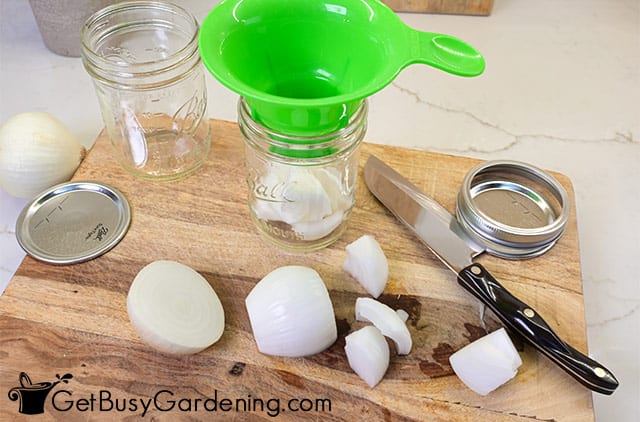
Pressure Canning Onions
Due to the low acidity of onions, the only safe way to process them is to use a pressure canner.
A boiling water bath will not be able to get them hot enough to kill off the potentially harmful bacteria, and therefore is not safe for home canning.
Tools & Equipment Needed
Below is a list of everything you’ll need to can your onions. You can see my full list of canning tools and supplies here.
- Pressure canner
- Pint canning jars
- OR Quart sized jars
- New jar lids
- Canning funnel
- Ladle
- Bubble remover tool
- Paring knife
- Kitchen or paper towels
- Cutting board
- Jar lifting tool
- Dissolvable labels
- OR Permanent marker
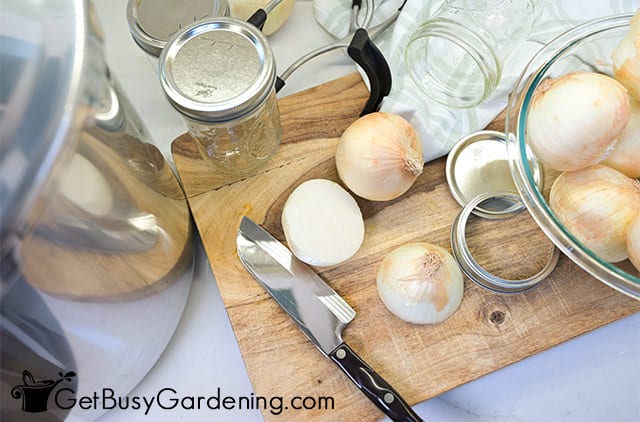
How To Store Canned Onions
Once the processed jars have cooled to room temperature and the lids have sealed, remove the bands before storing them.
Make sure to write the date on them with a permanent marker or use dissolvable labels so you know when they’ll expire.
Then store your canned onions in a cool, dry, and dark place, such as in a pantry or cupboard.
How Long Do Canned Onions Last?
Canned onions will last 6-8 months when stored properly. Test each lid before eating them to make sure it is still tightly sealed, and discard any that have popped.
How To Use Canned Onions
There are many uses for canned onions, and you can add them to any recipe that calls for cooked.
Some of my favorite ways to use mine are to make french onion soup or stews in the winter, or stirring them into my homemade pasta sauce.
I do recommend adding them as one of the last steps. Since they’re already cooked you really only need to warm them up.
Related Post: When & How To Harvest Onions
FAQs
Below are answers to some of the most common questions on canning onions.
What’s the best way to can onions?
The best and only safe way to can onions is in a pressure canner, due to their naturally low acidity. I also recommend raw packing them into the jars for the best texture.
Do you have to cook onions before canning?
No, you do not have to cook onions before canning them. In fact, leaving them raw is better in my opinion. You certainly could flash-cook them first, but it tends to make them mushier.
Can I can raw onions?
You can can raw onions, and this is my preferred method as I’ve found that hot packing makes them mushier after processing.
Can onions be water bath canned?
No, onions cannot be water bath canned. They are a low acid food, so pressure canning is the only safe method. A boiling water bath doesn’t get hot enough to kill potential bacteria.
What do canned onions taste like?
Canned onions taste like they’re cooked and slightly caramelized, so they’re milder in flavor and softer in texture than raw. They’re best enjoyed in a recipe, such as a sauce, gravy, or soup.
Can I can whole onions?
You can can whole onions as long as they are 1″ in diameter or smaller, like pearl onions or immature bulbs that didn’t grow fully in the garden. But larger ones must be cut into 2” wedges or pieces.
If you’d like to learn how to make the most of your space and get as much homegrown food as possible, then my Vertical Vegetables book is perfect! It will teach you all you need to know, has tons of gorgeous photos, and includes 23 DIY projects you can build for your own garden. Order your copy today!
Learn more about my Vertical Vegetables book here.
More Onion Recipes
More Food Canning Posts
- How To Can Rhubarb
- How To Can Asparagus
- How To Can Peas
- How To Can Corn
- How To Can Tomatillos
- How To Can Carrots
Share your tips for canning onions in the comments section below.
Recipe & Instructions
How To Can Onions
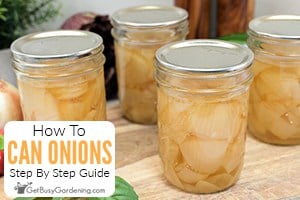
Canning onions is an easy and great way to preserve them for later use. Enjoy them year round in soups, stews, sauces, and more.
Ingredients
- 2 pounds of onions
- 4-5 cups of water (for filling the jars)
Instructions
- Prepare the pressure canner - Position the rack in the bottom of your pressure canner, then fill it with 2-3” of boiling water, or per the user manual. Different models may vary. Bring a cooking pot filled with 4-5 cups of water to a boil on the stove.
- Prepare the onions - Rinse your onions to remove any dirt or debris, then cut off both ends, remove the outer skin, and cut them into 2 inch pieces.

- Pack the jars - Add the cut up pieces into each canning jar, taking care to pack them tightly, and leaving a 1 ½" headspace on top.

- Add boiling water - Use your canning funnel and a large ladle to pour the boiling water over the onions to fill each jar, keeping 1” of headspace on top.

- Remove air bubbles - Use a bubble popping tool or wooden skewer to remove any large air bubbles from the jar. Don’t use a metal tool for this, as it can damage the glass.

- Place the lids and rings on - Wipe the rim of each jar with a damp paper towel. Then place a new lid on top, followed by a band, and twist just enough to secure them finger tight.

- Put the jars into the canner - Use your lifting tool to carefully place each jar into the canner right after you fill it so they don't have a chance to cool down.

- Lock the lid - Once all of the jars are inside, place the lid on your pressure canner, lock it into place, and bring it to a boil on high heat.
- Process the jars - Let the canner vent for 10 minutes before closing it, or until the vent closes automatically (depending on your canner). Continue heating to reach 11 PSI for a dial gauge, and 10 PSI for a weighted gauge. Then process the jars for 40 minutes.

- Remove the jars - Turn off the heat and allow the canner to cool completely before opening it and removing the jars. This can take 20 minutes. Place the jars on the counter to cool completely, then write the date on them with a permanent marker or use dissolvable labels, remove the bands, and store them in a cool, dark place.

Notes
- Although you can hot pack onions if you’d like, I suggest raw packing them to reduce mushiness during canning.
- Canned onions will be naturally soft because they are cooked during the process. You could try adding pickling salt to the jars (⅛ teaspoon per pint) to help them stay a bit crisper.
- It’s normal for the onions to float to the top during processing, but once they cool they will settle back into the jar.
- Because onions are a low acid food, they must be pressure canned. This is the only way to ensure all bacteria is destroyed, and that they are safe to eat.
- It's important to keep the jars hot at all times. So plan ahead and boil the processing water before filling them, then place them in there as soon as they are packed.
- Also, be sure to work fairly quickly to pack your jars so they do not cool down before processing them.
- Don't be alarmed if you hear the random pinging sounds as the jars cool, it just means the lids are sealing.
- If you live at an altitude higher than 1,000 feet above sea level, then you'll need to adjust your pressure pounds and processing time. Please see this chart for the proper conversions.
Nutrition Information:
Yield:
16Serving Size:
½ cupAmount Per Serving: Calories: 25Total Fat: 0gSaturated Fat: 0gTrans Fat: 0gUnsaturated Fat: 0gCholesterol: 0mgSodium: 14mgCarbohydrates: 6gFiber: 1gSugar: 3gProtein: 1g
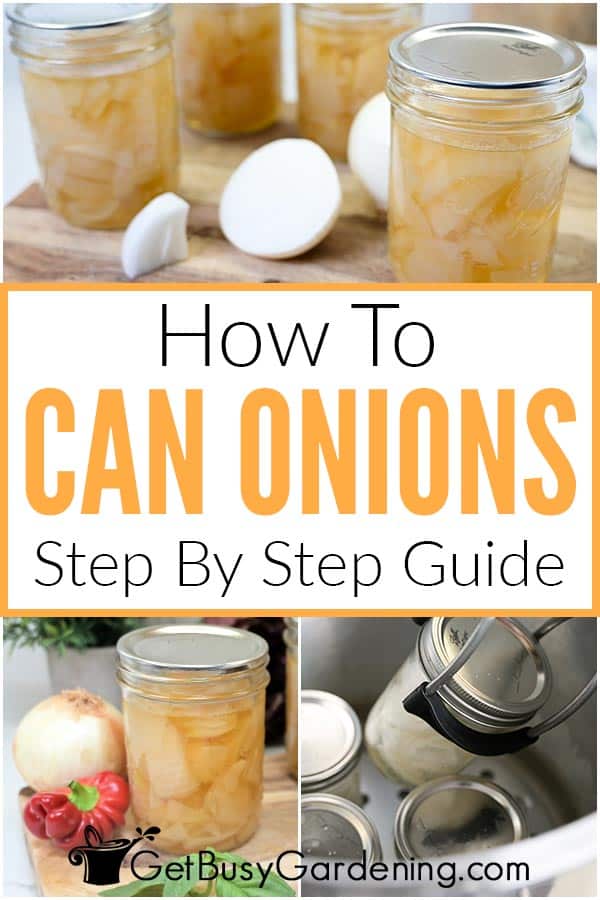
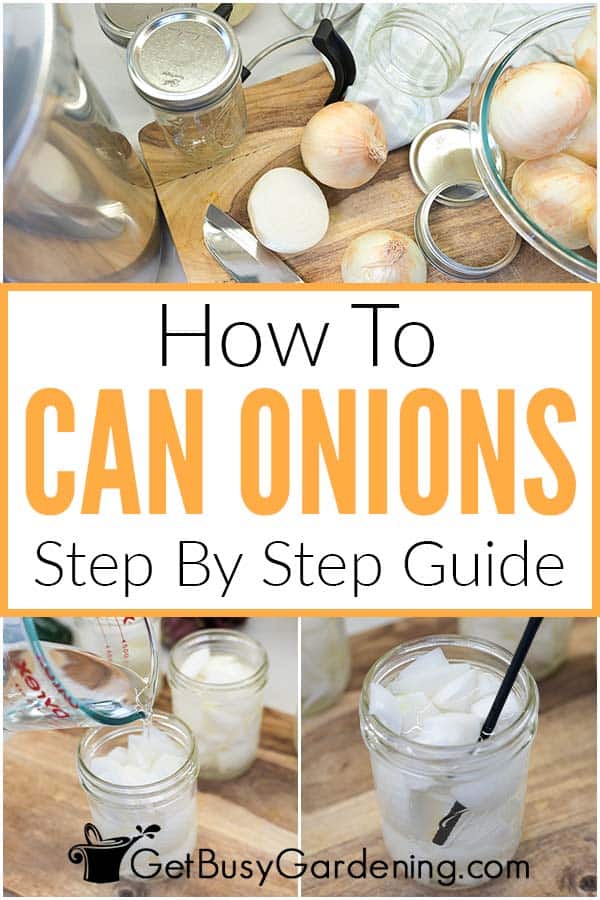
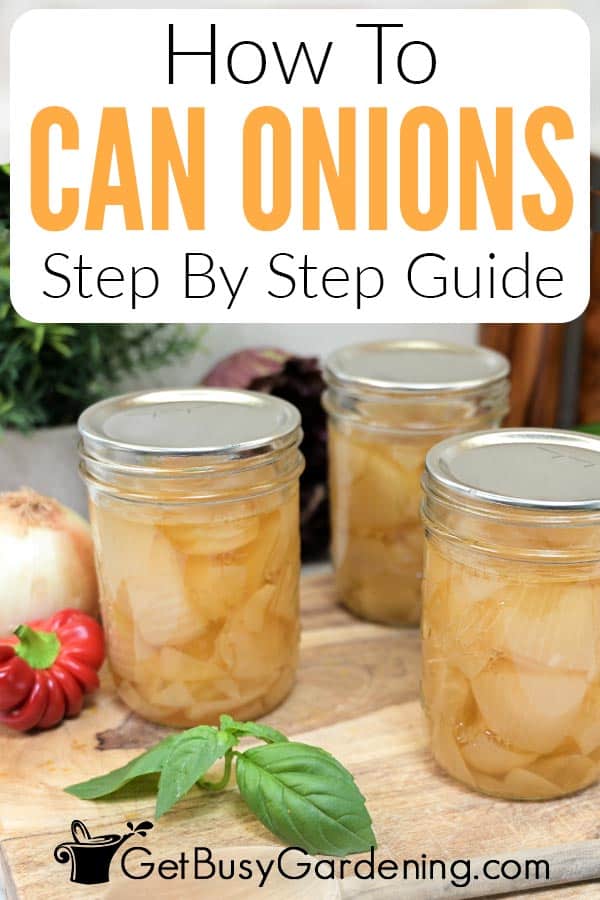

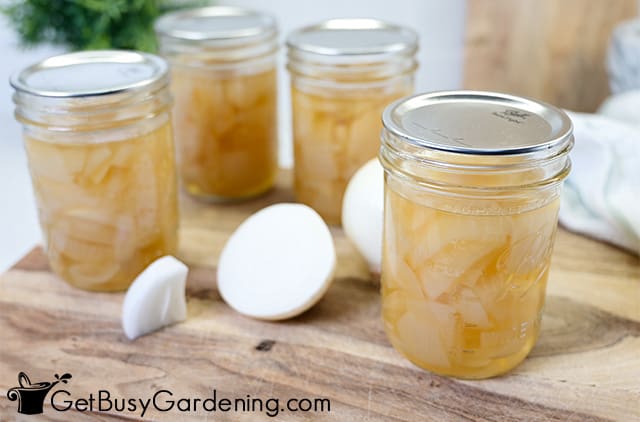
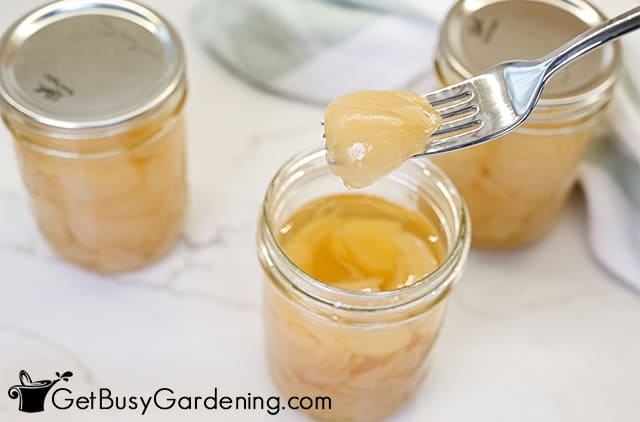

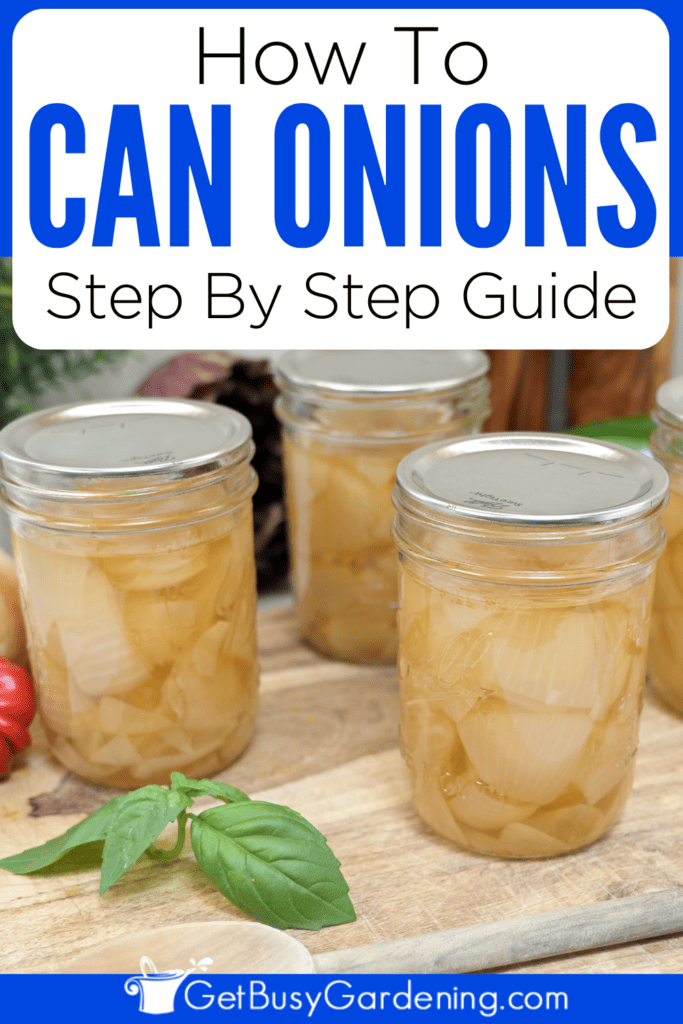
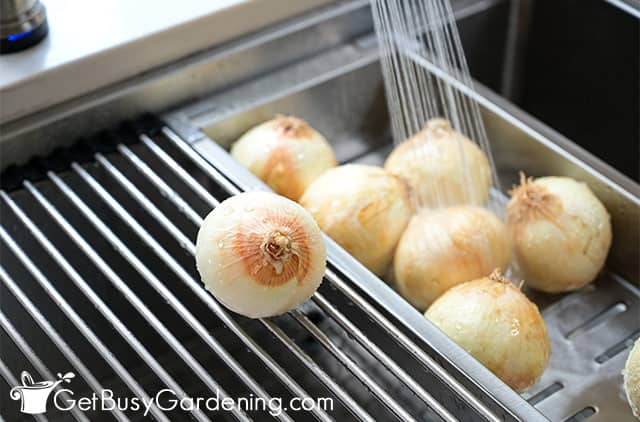
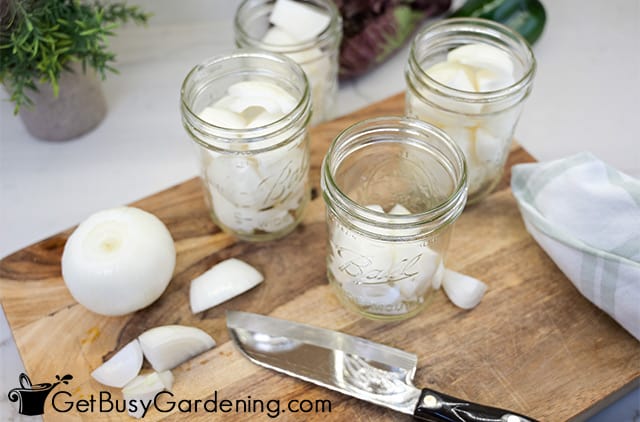
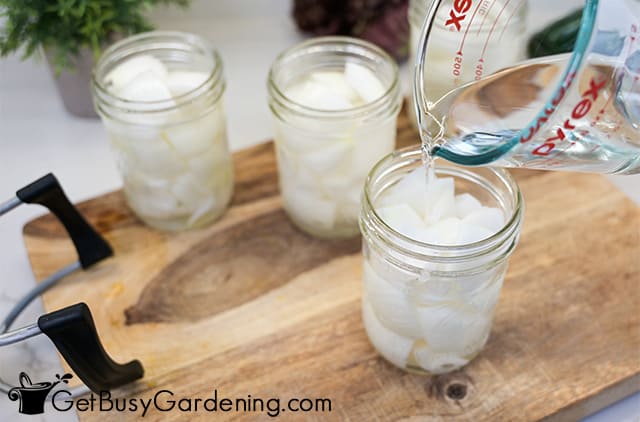

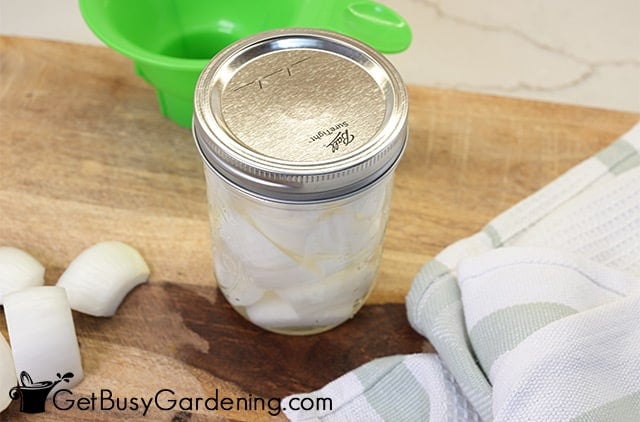
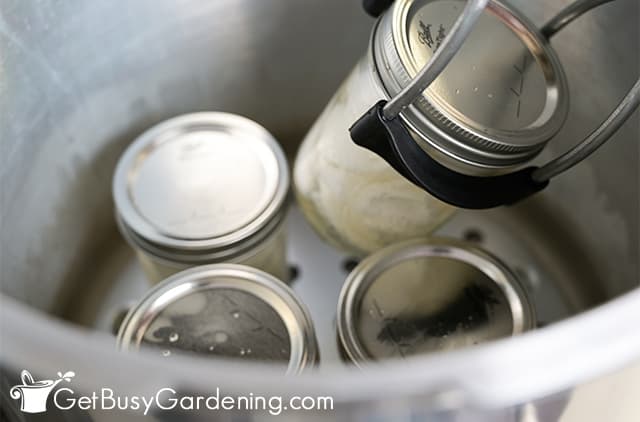
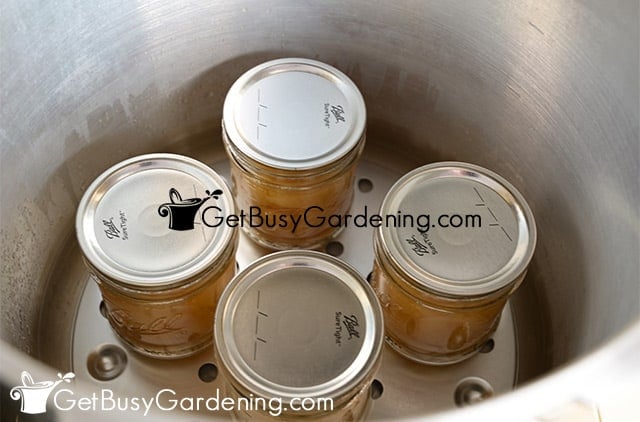
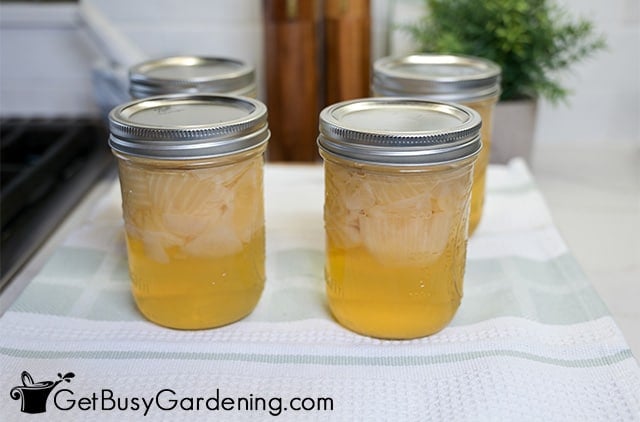

Yuka says
Thanks for the clear instructions!
Add this to my summer canning list 🙂
Amy Andrychowicz says
You’re welcome! 🙂
Mea says
How many pints does 2 lbs of onions make????
Amy Andrychowicz says
4 pints
Carol Larson says
Would it be possible to chop the onions more fine?. I think I’d like to do more of a quarter to half inch pieces. Would that work? Would there be a difference in processing time?
Amy Andrychowicz says
Cutting them in quarters will work, or you could cut them in half if the onions are small. I wouldn’t go too small, or they may get mushier than the larger pieces do after processing.
Mary Matt says
I have about 5 lbs of white onions and want to preserve them for later use. My question is how to can them but keeping them crisp like pickles until I want to use them as chopping them for cooking and not mush how do you raw pack and pressure cook but keeping them crisp?
Amy Andrychowicz says
You can pickle your white onions with this recipe. Enjoy!
Lorraine says
I bought some onions from farmer’s market, and have never pressure canned onions before. Thanks for the info and steps.
Amy Andrychowicz says
You’re welcome!